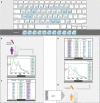Message in a molecule
- PMID: 27138465
- PMCID: PMC4857388
- DOI: 10.1038/ncomms11374
Message in a molecule
Abstract
Since ancient times, steganography, the art of concealing information, has largely relied on secret inks as a tool for hiding messages. However, as the methods for detecting these inks improved, the use of simple and accessible chemicals as a means to secure communication was practically abolished. Here, we describe a method that enables one to conceal multiple different messages within the emission spectra of a unimolecular fluorescent sensor. Similar to secret inks, this molecular-scale messaging sensor (m-SMS) can be hidden on regular paper and the messages can be encoded or decoded within seconds using common chemicals, including commercial ingredients that can be obtained in grocery stores or pharmacies. Unlike with invisible inks, however, uncovering these messages by an unauthorized user is almost impossible because they are protected by three different defence mechanisms: steganography, cryptography and by entering a password, which are used to hide, encrypt or prevent access to the information, respectively.
Figures






Similar articles
-
Molecules that Generate Fingerprints: A New Class of Fluorescent Sensors for Chemical Biology, Medical Diagnosis, and Cryptography.Acc Chem Res. 2023 Jul 4;56(13):1803-1814. doi: 10.1021/acs.accounts.3c00162. Epub 2023 Jun 19. Acc Chem Res. 2023. PMID: 37335975 Free PMC article. Review.
-
Seek-and-Hide: Adversarial Steganography via Deep Reinforcement Learning.IEEE Trans Pattern Anal Mach Intell. 2022 Nov;44(11):7871-7884. doi: 10.1109/TPAMI.2021.3114555. Epub 2022 Oct 4. IEEE Trans Pattern Anal Mach Intell. 2022. PMID: 34550880
-
A Two-Phase Embedding Approach for Secure Distributed Steganography.Sensors (Basel). 2025 Feb 27;25(5):1448. doi: 10.3390/s25051448. Sensors (Basel). 2025. PMID: 40096275 Free PMC article.
-
Modern Text Hiding, Text Steganalysis, and Applications: A Comparative Analysis.Entropy (Basel). 2019 Apr 1;21(4):355. doi: 10.3390/e21040355. Entropy (Basel). 2019. PMID: 33267069 Free PMC article. Review.
-
A novel steganography method for binary and color halftone images.PeerJ Comput Sci. 2022 Aug 16;8:e1062. doi: 10.7717/peerj-cs.1062. eCollection 2022. PeerJ Comput Sci. 2022. PMID: 36091978 Free PMC article.
Cited by
-
On-line Ammonia Sensor and Invisible Security Ink by Fluorescent Zwitterionic Spirocyclic Meisenheimer Complex.Sci Rep. 2017 Jan 16;7:40465. doi: 10.1038/srep40465. Sci Rep. 2017. PMID: 28091542 Free PMC article.
-
Molecular Steganography Using Multistate Photoswitchable Hydrazones.J Am Chem Soc. 2025 Jun 11;147(23):19444-19449. doi: 10.1021/jacs.5c03668. Epub 2025 May 28. J Am Chem Soc. 2025. PMID: 40435281 Free PMC article.
-
Combined Experimental and Theoretical Studies on the Rubbing-Induced Fluorescence Behavior of a Luminophore in the Solid State.ACS Omega. 2022 Dec 20;8(1):373-379. doi: 10.1021/acsomega.2c04803. eCollection 2023 Jan 10. ACS Omega. 2022. PMID: 36643439 Free PMC article.
-
Population analysis to increase the robustness of molecular computational identification and its extension into the near-infrared for substantial numbers of small objects.Chem Sci. 2019 Jan 16;10(8):2272-2279. doi: 10.1039/c8sc05548c. eCollection 2019 Feb 28. Chem Sci. 2019. PMID: 30881652 Free PMC article.
-
Synthetic DNA applications in information technology.Nat Commun. 2022 Jan 17;13(1):352. doi: 10.1038/s41467-021-27846-9. Nat Commun. 2022. PMID: 35039502 Free PMC article. Review.
References
-
- Macrakis K. Prisoners, Lovers, and Spies: The Story of Invisible Ink from Herodotus to al-Qaeda Yale Univ. (2015).
-
- Jamil T. Steganography: the art of hiding information in plain sight. IEEE Potentials 18, 10–12 (1999).
-
- Macrakis K., Bell E. K., Perry D. L. & Sweeder R. D. Invisible ink revealed: concept, context, and chemical principles of ‘cold war' writing. J. Chem. Edu. 89, 529–532 (2012).
-
- Kishimura A., Yamashita T., Yamaguchi K. & Aida T. Rewritable phosphorescent paper by the control of competing kinetic and thermodynamic self-assembling events. Nat. Mater. 4, 546–549 (2005). - PubMed
-
- Mutai T., Satou H. & Araki K. Reproducible on-off switching of solid-state luminescence by controlling molecular packing through heat-mode interconversion. Nat. Mater. 4, 685–687 (2005). - PubMed
Publication types
Grants and funding
LinkOut - more resources
Full Text Sources
Other Literature Sources

